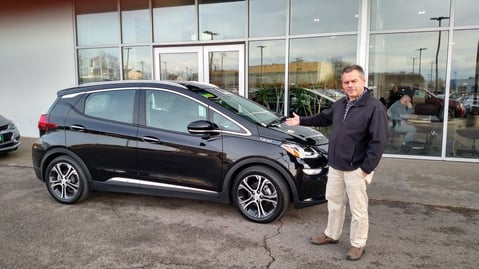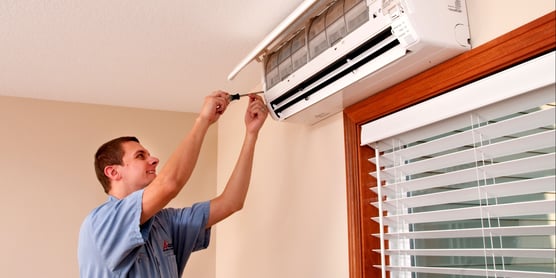Why We Need a (Good) Clean Heat Standard – a message for Massachusetts & Rhode Island
Energy standards have changed our electricity and auto industries for the better. Now it’s time to bring the same...
The science is clear. We all must phase out fossil fuels, the sooner the better, but no later than 2050. But there is no one path for us all on the journey to zero carbon. Each family’s situation is different from their neighbor’s. In my family’s case, we are not all the way to zero yet, but we are making good progress. Hopefully, this story will generate some ideas for your household.
When we bought the house, we went for the basics, starting with an energy audit from Mass Save. This led us to receive rebates on insulation (a lot more in the attic), appliances, and lighting. Compared to similar-sized homes, our gas and electricity usage has always been significantly lower than average.
 Back in 2000, electricity was the largest source of carbon emissions in New England. In response, Green Energy Consumers Alliance started a program for households and businesses to buy green electricity from renewable sources like wind and solar. Naturally, we enrolled, committing to 100 percent wind power. You can too here. But a lot has changed over time. State law now mandates electricity suppliers increase the percentage of renewable energy in the mix each year. With power plants no longer using oil and coal, today’s electricity mix is much cleaner than that of 2000, and will eventually reach zero carbon.
Back in 2000, electricity was the largest source of carbon emissions in New England. In response, Green Energy Consumers Alliance started a program for households and businesses to buy green electricity from renewable sources like wind and solar. Naturally, we enrolled, committing to 100 percent wind power. You can too here. But a lot has changed over time. State law now mandates electricity suppliers increase the percentage of renewable energy in the mix each year. With power plants no longer using oil and coal, today’s electricity mix is much cleaner than that of 2000, and will eventually reach zero carbon.
For consumers enrolled in Green Municipal Aggregation, zero carbon will come sooner. Our report highlights the widespread adoption of aggregation, showcasing its cost-effectiveness compared to conventional utility offerings.
Note: We would love to have solar panels, but our home is not well-suited for that. Our roof pitch is east/west, we have a lot of nice shade, and dormers that break up the roof line. But if we were a good candidate for solar, we would take advantage of this great program.
About nineteen years ago, we built an addition to the house to make way for Child #2. But thanks to building code advancements, the new part of the house is much tighter than the old part. We also switched from an old gas steam system to a high-efficiency gas with baseboard heat. Our gas consumption is about the same as it was when we had steam, even though we almost doubled our square footage.
At one point, our clothes dryer crapped out. We replaced it with a high-efficiency electric dryer. So now we dry our clothes on wind power. This was a small step towards zero carbon, but an easy one.
 In 2014, we took a much bigger step. We shopped around for an electric car and settled on a Chevy Volt, a plug-in hybrid. With that car, we drove on wind power for about 80% of our miles and used the gasoline engine for the remainder. We also had a Prius but used the Volt as much as possible.
In 2014, we took a much bigger step. We shopped around for an electric car and settled on a Chevy Volt, a plug-in hybrid. With that car, we drove on wind power for about 80% of our miles and used the gasoline engine for the remainder. We also had a Prius but used the Volt as much as possible.
Over the years, we traded in the Volt (which got 38 miles on a charge) and the Prius. Today, we have another Volt (which gets 53 miles per charge) and a fully electric Chevy Bolt. About 99 percent of our miles each year are zero emission. When the Volt dies or gets traded in, we will get another all-electric car through this great program or make do with the Bolt.
Thanks to federal tax credits and state rebates, since 2014, I know we have spent less than the average family on car payments. And we have spent considerably less on energy (running a motor on electricity costs less than running an engine on gasoline) and maintenance (most of the things that cause car repairs on a gasoline-powered car don’t exist in an EV).
As stated above, we have a high-efficiency gas boiler and a lot of insulation, so our gas bill is not very high. But the indirect hot water was getting old, so we just recently replaced it with a heat pump water heater. Thanks to the federal Inflation Reduction Act, it qualifies for a 30% tax credit after taking a $750 rebate from Mass Save. So now we take hot showers on wind power. This is a good medium-sized step towards being fossil fuel free.
Note: We also upgraded our electrical panel from 100 amps to 200 amps. Because we did it in the same year as replacing the hot water tank, we will get another $600 tax credit.
Another modest step towards zero carbon will be replacing our gas stove with an electric induction stove. This will further reduce our greenhouse gas emissions, but also indoor emissions that can damage our health. It's a task for 2024 after we do some shopping. Consumer Reports will come in handy.
 Our family is pretty far along to zero carbon. We are certainly well ahead of the pace of having emissions reduced 50% by 2030 (Massachusetts law, Rhode Island is 45%). And so far, home economics have been in our favor, and we have not had to compromise on convenience or comfort. But to get to zero, we need to replace that methane-fired heating system with heat pumps. The Inflation Reduction Act tax credit for heat pumps (and many other clean energy products) will last another 10 years, so we expect to make the move in that time frame. We will also keep our eye on incentives from Mass Save.
Our family is pretty far along to zero carbon. We are certainly well ahead of the pace of having emissions reduced 50% by 2030 (Massachusetts law, Rhode Island is 45%). And so far, home economics have been in our favor, and we have not had to compromise on convenience or comfort. But to get to zero, we need to replace that methane-fired heating system with heat pumps. The Inflation Reduction Act tax credit for heat pumps (and many other clean energy products) will last another 10 years, so we expect to make the move in that time frame. We will also keep our eye on incentives from Mass Save.
The race to zero carbon is not a sprint, nor is it a marathon. It is kind of a middle-distance race. It will be a good day when we have the old gas heating system and gas meter removed from the house. When that day comes, we will look back and remember that we did not make the leap overnight, but we took several steps in different years as circumstances arose. Hopefully, this approach makes sense for your family too.
Energy standards have changed our electricity and auto industries for the better. Now it’s time to bring the same...
The Baker Administration just released its Clean Energy & Climate Plan (CECP) as required by the Global Warming...
Comments